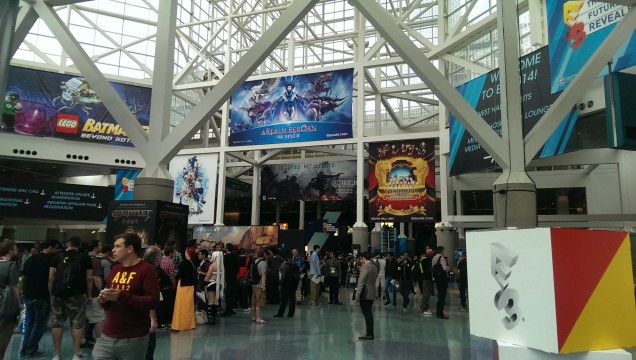
E3 Attendance, 2004-2010:
- 2004: ~65,000
- 2005: ~70,000
- 2006: ~60,000
- 2007: ~10,000
- 2008: ~5,000
- 2009: ~41,000
- 2010: ~45,000
(Source: the ever-infallible Wikipedia. Seriously, there is an entire Wikipedia page devoted to E3 history?)
I used to say that E3 was the Woodstock of video games. Maybe it’s better to say that Woodstock was the E3 of music festivals. The gaming industry is now bigger than movies and music, and E3 is revered as the high point of gaming hype. The hype is probably unrealistic– invariably fans will nitpick and complain about the Big Three press events, the games, and what was missing. That doesn’t keep fans from coming back with as much enthusiasm as Oakland Raiders fans during the NFL Draft.
Much of the love comes from the masses watching from home– the online streaming coverage of E3, in particular, has come a long way– but don’t discount the crowds on the show floor. Last year close to 50,000 members of the gaming press converged on Los Angeles for the big show, and similar numbers are expected this year. The wave of enthusiasm from them will fill all corners of the Internet, from the corporate sites to the indie blogs. I honestly think those watching from afar experience a sort of solidarity from watching the crowds roam the show floor, like fans at home feeling like they are there with the loud fans at a playoff hockey game. What happens in LA is infectious.
Conversely, if LA is dead, so is fan enthusiasm. Several years ago, E3 nearly accomplished just that.
It was 2006, and the E3 showrunners were frustrated. The problem certainly wasn’t lack of attendance; I mean, look at the numbers up above. The problem was too much attendance. E3 was packed, and with all kinds of people, not all of whom bore the appearance of serious video game journalists. No one really disputed this; credentials were relatively easy to come by. Have a blog, pay your way, go to E3. But this was supposed to be a trade show, not a fan convention, the organizers argued. Developers and publishers wanted to see serious journalists, they said, not waste time giving demos to random folks in cosplay.
So in the summer of 2006 the Entertainment Software Association (ESA) announced it was making radical changes to the E3 format. The show was moved from LA to smaller quarters in Santa Monica and renamed the E3 Media and Business Summit. Attendance now would be by invite only, and would be restricted to outlets that met specific journalistic criteria. Even smaller “credible” sites that were invited had caps put on how many members could attend. To compensate for those excluded from E3, the ESA also announced a companion event, Entertainment for All, which was held in LA during the fall and positioned as the alternative for all the spurned E3 faithful.
The “new” E3 ran for two years, and by most measures it was a failure. The first year, 2007, was a 10,000-person snoozefest, and only half that number came back for 2008. Anyone watching at home could see the collective disappointment by the media on site as they roamed the quiet, sterile environs. There were no crowds and no excitement. Even the show’s ill-conceived new name– the E3 Media and Business Summit– sounded more like stuffy business-speak than actual entertainment. The timing was probably not the most ideal, either, as Sony and Nintendo had just released new systems (PlayStation 3 and Wii) the previous November and the games available on those systems were still relatively few. (Nintendo’s big game reveal in 2007 was Wii Fit and its Wii Balance Board, a good game but hardly a hardcore fan’s dream. Nintendo’s 2008 conference was an epic fail.) All in all, it was a perfect storm of a flop.
As for the Entertainment for All expo that was supposed to attract everyone else? I can’t find numbers for 2008, but 2007 drew about 18,000 attendees. I’m guessing 2008 wasn’t an improvement.
By the time 2008’s E3 ended, fan interest had dropped precipitously and some media outlets were predicting E3’s impending demise. What the ESA failed to fully appreciate, but eventually realized, was how important fan enthusiasm on site was for broader mass hype. The new E3 was like watching a baseball game on TV where only 15,000 fans showed up. Their initial relief at purging the so-called undesirables was soon supplanted by a growing realization that E3 just wasn’t as worth watching any more. Their iconic trade show was on the cusp of irrelevancy.
At that point the ESA took the only option available to them: they backtracked frantically. E3 2009 came back to Los Angeles, and once again the admission requirements were expanded. For whatever reason, the attendance numbers have never quite returned to pre-2006 form, but the hype quickly came back. The Big Three even delivered a timely motion-sensing arms race. I will not soon forget that E3 for another reason; it marked the debut trailer for what we now call Xenoblade Chronicles. Nintendojo’s then-Editor-in-Chief, Noah Ward, was on the floor of E3 waiting to demo Nintendo’s goods when I called him asking him to look into the mysterious trailer, which was for a game first called Monado: The Beginning of the World. I remember him screaming back “Monado? What’s that?”
No one would say that about E3. At least, not now.




 ShareThis
ShareThis






